Erfoud fossils for sale in Morocco
Morocco Expedition offers fossils in erfoud
Erfoud fossils in Morocco
Morocco is one of the world’s most geographically diverse countries, bordered to the west by the Atlas Mountains and to the east by the Sahara Desert. Because of the dry climate, large amounts of rock are exposed, making it easy to understand the geology. Nature lovers will find fascinating natural features such as folded rocks, towering sand dunes, and abundant fossil beds dating from the pre-Cambrian to the Recent geological epochs. Trilobites, ammonites, and other ancient living fossils such as dinosaurs, coral, and shark teeth can be found in eastern Morocco, particularly in Erfoud. Paleontologists have been able to greatly update the geological record thanks to excavations in Morocco.
It’s hard to believe that the Sahara desert was once a shallow sea millions of years ago. Ammonites, Orthoceras, and Trilobites, among other prehistoric marine animals, thrived in this sea and accumulated on the bottom when they died. Over millennia, their remains were buried in mud and turned into stone. The spiral bodies of ammonites distinguish them from modern-day snails (mollusks). Orthoceras, like modern squids, have a small body and a ‘toothlike’ beak. The rigid exoskeleton of trilobites is divided into three distinct segments that fossilize well. These ground organisms are the ancestors of modern insects, spiders, centipedes, lobsters, and crabs.
The Kem Kem Beds formation is a well-known archaeological site in southern Morocco, between Morocco and Algeria. A sheepherder in the small desert settlement of Hassi Begaa discovered fish bones in 1991. This heightened interest in the area, resulting in the discovery of several dinosaur bones and footprints. The Spinosaurus, the first known semi-aquatic dinosaur, was one of the most exciting finds. It is considered to be the world’s largest predatory dinosaur, far bigger than a T-rex! In Egypt, similar skeletons have been discovered.
In Morocco, where can you locate and purchase fossils?
The best place in Morocco to collect fossils is near the town of Erfoud, which is located in the center of the Ziz Oasis, adjacent to the famous Erg Chebbi Desert. Tourists may get a firsthand look at the process of finding and extracting fossils by visiting the Museum of Fossils and Minerals or one of the area’s fossil factories.
Many Berber families from Erfoud and Midelt have been involved in fossil mining and preservation for many decades. Hand-dug trenches using shovels, picks, and chisels are mined, marble rocks are recovered, and rock fragments from fossils are hand micro-blasted. Other large pieces of marble may be carved and polished to make tables, fountains, soap dishes, bowls, pendants, and other decorative items. These items may be found at Erfoud, as well as Marrakech and Fes souks. Large items, like as fountains, may be purchased in Erfoud and sent anywhere in the world.
For sale are Erfoud fossils.
Ammonites
Morocco is rich in Devonian Limestone, which dates back 350 million years. Ammonites, which may today be found in Morocco, used to flourish in a warm, shallow sea that covered what is now the Sahara Desert. As the creatures’ shells accumulated on the sea floor, they were buried by sediments and transformed into stone over time via physical and chemical processes.
They are now extracted from a marble (calcium carbonate) deposit. Moroccan artisans from Erfoud carved and polished the stones to provide a rare picture of past life on Earth.
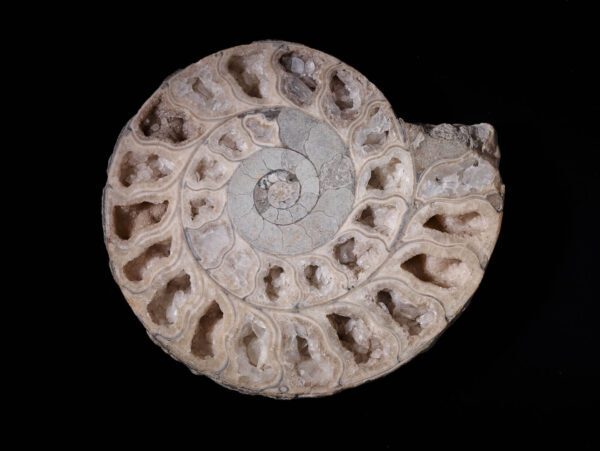
Tables of fossils
Nature’s craftsmanship may be seen in these exquisite stone tables. The Table clearly portrays the Moroccan desert’s 345 million-year-old marine life. These are one-of-a-kind things that will compliment the décor of your house. Marble is a natural stone that has long been utilized in sculpting and architecture.
Marble’s beauty is widely renowned around the world. Marble is used in many of the world’s prominent buildings. Marble slabs are often utilized in the building industry for vanity tops, tabletops, tub decks, furniture tops, slab showers, and, in rare cases, kitchen surfaces. All of our building, design, and architectural items come in a variety of sizes and other bespoke options.
These are really one-of-a-kind items for the opulent décor of hotels, restaurants, households, and companies, among others. They are excellent for both indoor and outdoor usage. Our fossil marble tables are available in a range of styles. They are all adorned with authentic fossils dating back millions of years, such as Orthoceras (500 million years), ammonites, and corals (400 to 60 Million years ). This exhibit showcases a chunk of our planet’s history printed on high-end items.
In addition to these tables, we have a large selection of home furniture and décor components made from fossil marble. We manufacture on-demand and according to your specific specifications and measurements. We may also develop bespoke items depending on your specific needs or ideas.
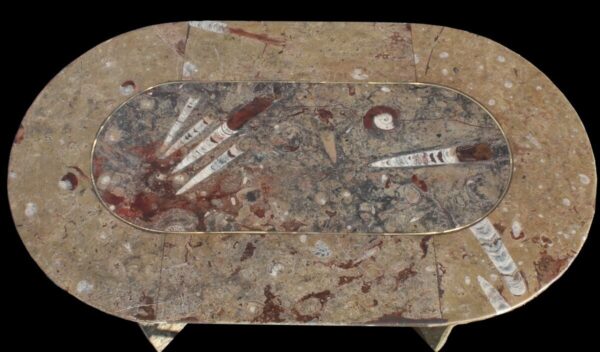
Sinks
Nature’s craftsmanship may be observed in these lovely stone sinks. The 345 million-year-old fossil Ammonites and Orthoceras in each Sink provide a spectacular natural beauty to your bathroom. These are one-of-a-kind things that will enhance your home’s decor.

Orthoceras
Orthoceras was one of the first Cephalopoda found in the fossil record. Cephalopods are fast-moving predatory sea invertebrates. This category includes live squid, octopi, and nautiloids. Orthoceras was a squid-like monster with eyes, tentacles, and a ‘toothlike’ beak that they used to rip apart their victims. To cover their escape from an attacker, they may spew ink.
Orthoceras lives in an elongated and straight shell. A group of ‘uncurled’ cephalopods first arose during the Ordovician Period. A subset of them developed into a semi-coiled form, which is regarded to be an older (earlier) form that gave birth to curled ammonites (now extinct) and nautiloids (which still dwell in the world’s seas today).
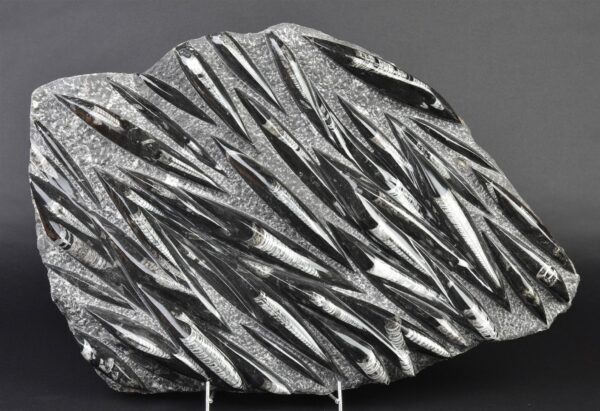
Trilobites
Trilobites are named from the three distinct components of their segmented body. The hard exoskeleton preserved fossils well and served as protective armor, but it had to be shed on a regular basis as the animal grew. These multi-legged arthropods scoured the sandy seafloors and coral reefs for food.
The trilobite was the first animal found to have vision. Because of the incredible construction and preservation of trilobite eyes, scientists can study the evolution of a sensory organ that is extremely seldom retained in other creatures. Trilobites have been around for almost 300 million years, from the Cambrian through the Permian eras.
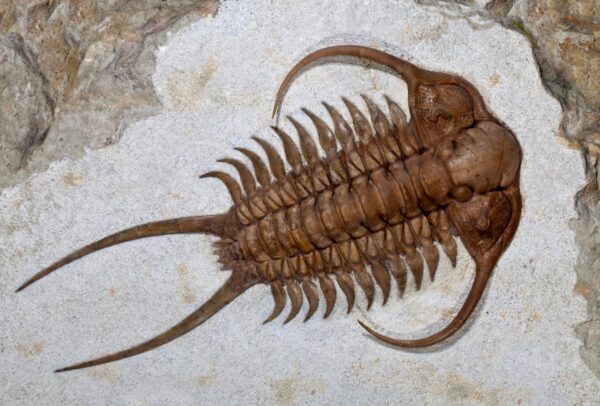
Decorative items
You are holding a piece of the ancient Moroccan sea when you hold one of these Boxes or Paperweights. The boxes all have lids and may be used to contain jewelry, valuables, cash, keys, and so on. The “paperweights” may be used to hold valuable specimens, beautiful objects, fish tank displays, and other items, and they make great gifts. Each piece displays the outstanding craftsmanship.
This page’s handcrafted Bowls are an excellent example of Moroccan artistry. Each bowl includes an Ammonite or Orthoceras fossil. These lovely objects look excellent in any situation. Each one is one-of-a-kind, hand-picked, and of the finest quality. This page’s plates and platters are totally handcrafted in Morocco. They showcase the extraordinary natural beauty of the Ammonite and Orthoceras fossils. These 345 million-year-old sea fossils were unearthed in a desert.
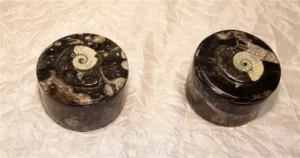

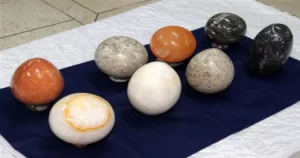

Note : Please contact us if you want to view additional photographs or inquire about the costs of our items. Also, if you have any questions or comments, please contact us by email or WhatsApp.
